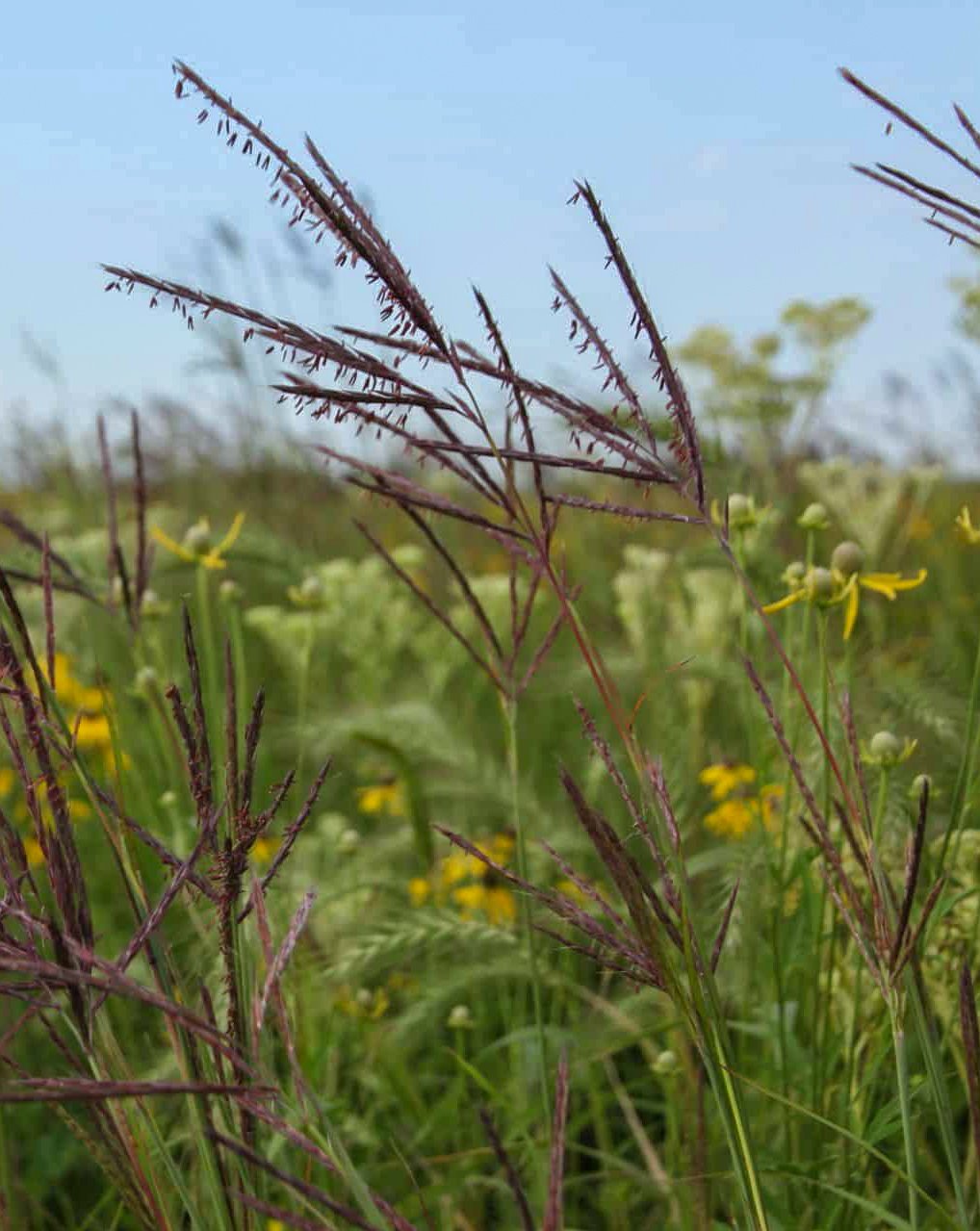 Image 1 of 7
Image 1 of 7

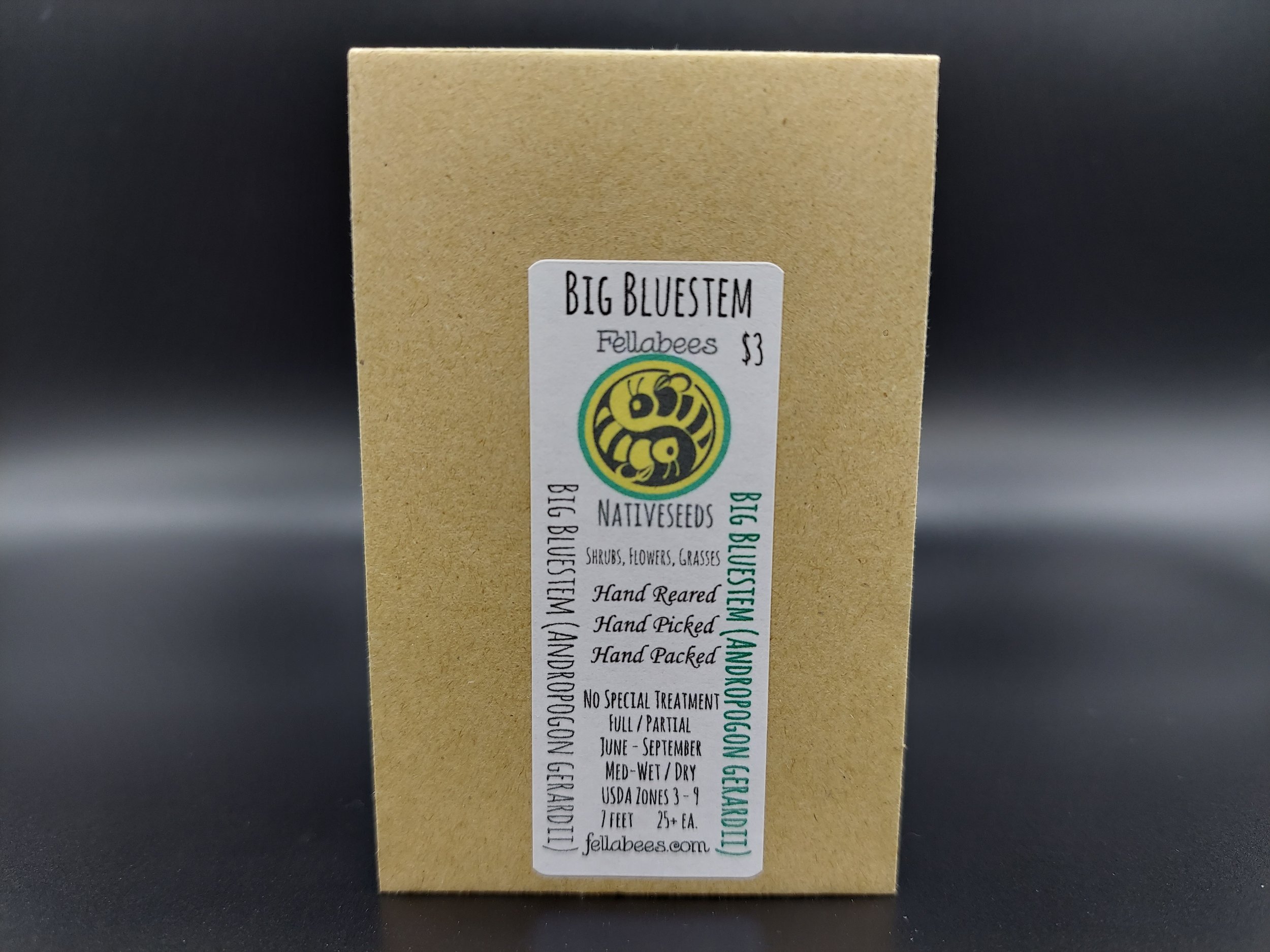 Image 2 of 7
Image 2 of 7

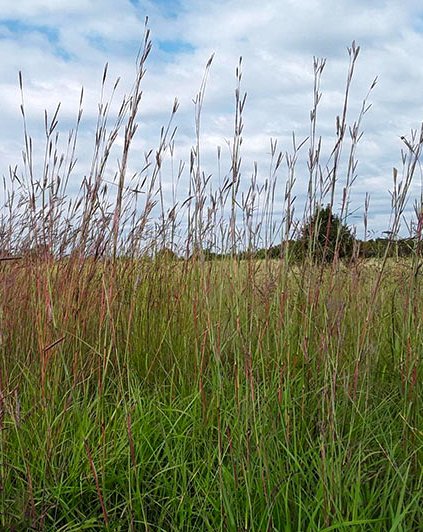 Image 3 of 7
Image 3 of 7

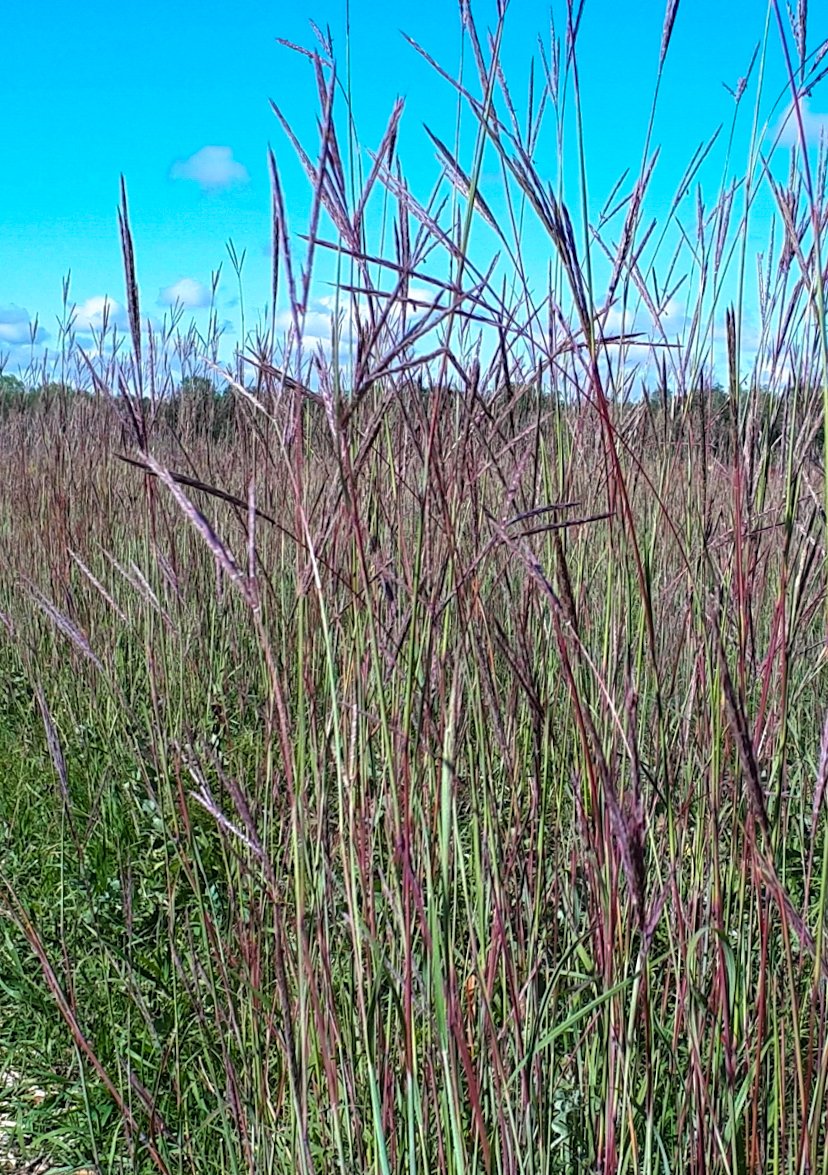 Image 4 of 7
Image 4 of 7

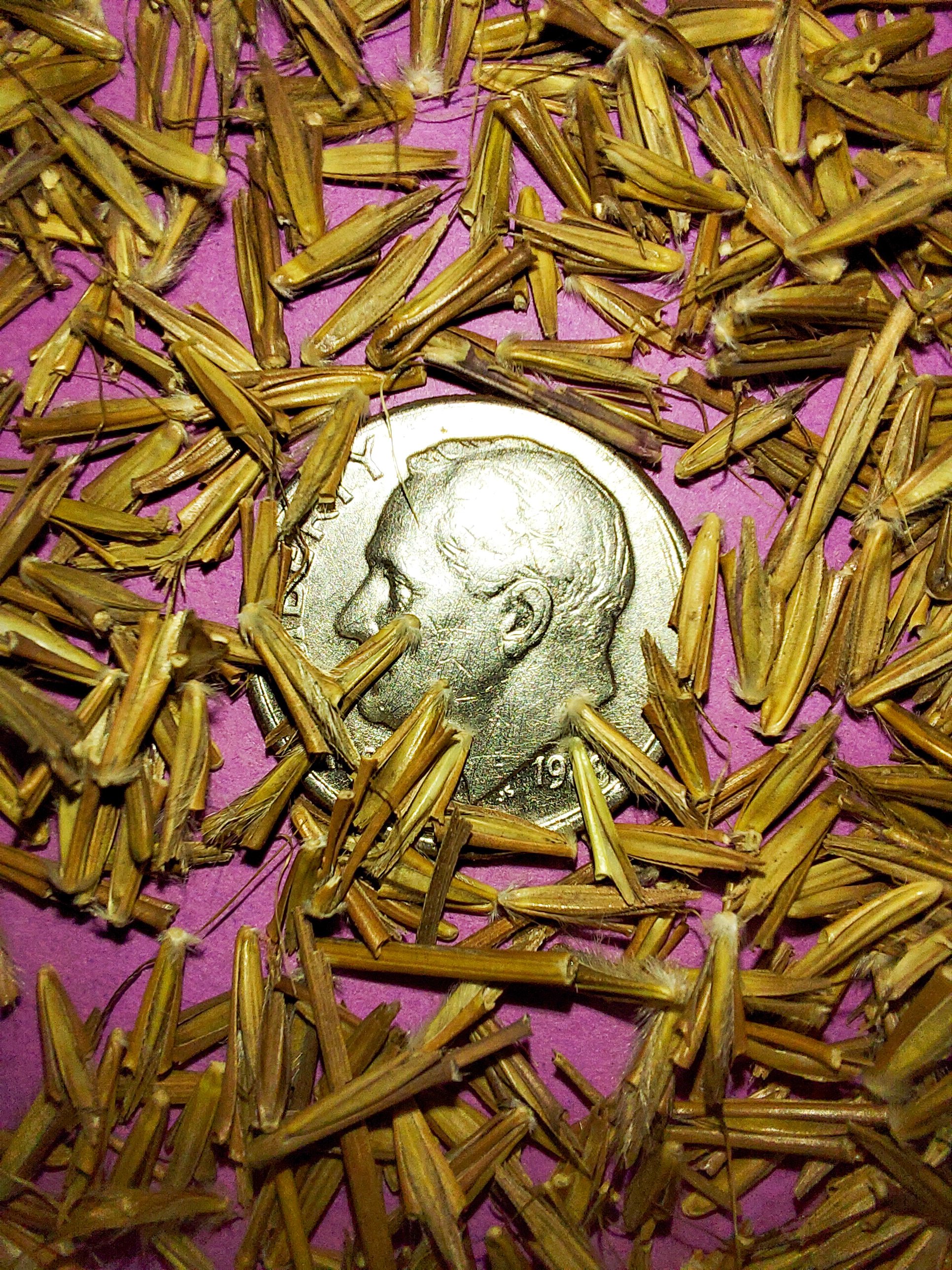 Image 5 of 7
Image 5 of 7

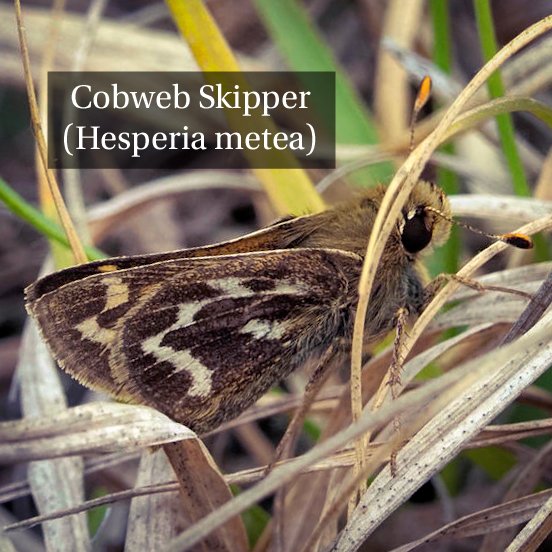 Image 6 of 7
Image 6 of 7

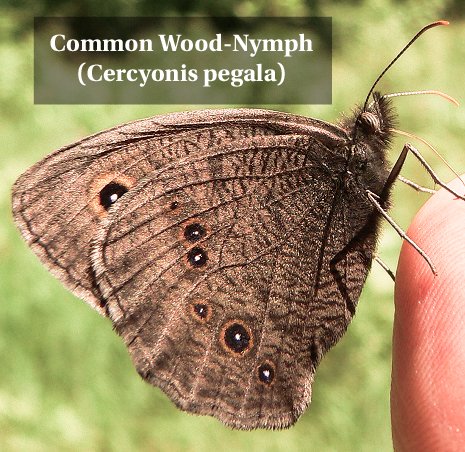 Image 7 of 7
Image 7 of 7








Big Bluestem (Andropogon gerardii)
Big Bluestem (Andropogon gerardii)
Andropogon gerardii is the scientific name for the native plant more commonly known as Big Bluestem.
Big Bluestem is a species of tall grass native to much of the Great Plains and grassland regions of central and eastern North America. It is also known as Tall Bluestem, Bluejoint, and Turkeyfoot.
Big Bluestem is a perennial warm-season bunchgrass. It is exceptionally tolerant of a wide range of soil conditions.
The main roots are found to be 6–10 ft deep, and the plants send out strong, durable rhizomes forming a dense sod. Depending on soil and moisture conditions, Big Bluestem grows to a height anywhere between 3.3–9.8 feet depending on seasonal conditions. As the name suggests the stem base turns blue or purple as it matures.
Big Bluestem blooms in the summer and seeds into the fall. The inflorescence (cluster of flowers) is a raceme of two to six, but most commonly three, narrow spike-like racemes alternately arranged along the top of the stem. As another colloquial name suggests the flowerhead somewhat resembles a wild turkey's foot. Each raceme contains pairs of spikelets. Each pair has a stalked spikelet with another stalkless spikelet at the base of the stalk. The stalkless spikelet usually has a fertile, perfect floret (with both female and male parts) and an awn (bristle), and the stalked spikelet is awnless, and is sterile or has a staminate (male) flower.
Big bluestem is a mid-successional grass in prairie and other grassland ecosystems. It grows in tall, dense stands that can outcompete other plant species. The stands continue to grow until disturbance interrupts their spread.
Big Bluestem dislikes shade but is exceptionally well adapted to fire, and benefits from infrequent burns.
Big Bluestem is a prolificly dynamic grass as a host to larvae of several species of butterflies, including the endangered Arogos Skipper Butterfly (Atrytone arogos), Byssus Skipper Butterfly (Problema byssus), Cobweb Skipper Butterfly (Hesperia metea), the endangered Ottoe Skipper Butterfly (Hesperia ottoe), Common Wood Nymph Butterfly (Cercyonis pegala), Delaware Skipper Butterfly (Anatrytone logan), Dusted Skipper Butterfly (Atrytonopsis hianna) as well as the Northern Pearly Eye Butterfly (Lethe anthedon)!
The larvae of the The Black Diabrotica Beetle (Diabrotica cristata) feed on the roots and the adults visit and pollinate the flowers of other species of prairie plants.
Many ant species decorate their nests with the seeds of Big Bluestem, including Formica glacialis, Formica montana, and Formica subsericea. Several additional species of ants including the formerly mentioned but also Lasius minutus, and Lasius umbratus build nests around the base of this bunchgrass, forming large soil mounds.
Amazingly in larger mounds, the nests can become communal between many varied species and is shared by multiple species of ants, and is treated like an apartment complex with each ant species in its own nest partition.
Up to 12 species of ants have been recorded in well established mounds found in the Midwest regions including Chicago, Milwaukee and Appleton, Wisconsin.
The grass and its variants provide good forage for horses and cattle, and can also be cut and used for hay. The grass is high in protein. While typically not considered the highest quality native forage found in the United States, it has long been considered a desirable and ecologically important grass by rangeland ecologists.
Big Bluestem is cultivated by specialty plant nurseries for its drought tolerance and native status. It is often grown for wildlife gardens, natural landscaping, and grassland habitat restoration projects.
Known to be fairly aggressive and due to its exceptional height, consideration is needed before planting in small settings.
Plant Details
USDA Zones: 3-9
Germination Needs: Needs no special treatment
Life Cycle: Perennial
Sun Exposure: Full to Partial
Soil Moisture: Medium-Wet, Medium, Medium-Dry, Dry
Plant Spacing: 2-3 feet
Height: 7 feet
Bloom time: June, July, August, September
Bloom Color: Green/Blue/Brown
Advantages :
Pollinator Favorite: butterflies, moths
Bird Favorite: seeds, insects, fruit, nectar, nesting, perchs.
Deer Resistant: Yes
Native to : Wisconsin, Minnesota, Iowa, Illinois, Indiana, Michigan, Ohio, Pennsylvania, New York, Vermont, New Hampshire, Maine, Massachusetts, Rhode Island, Connecticut, Delaware, Maryland, New Jersey, West Virginia, Virginia, Kentucky, Tennessee, North Carolina, South Carolina, Georgia, Florida, Alabama, Mississippi, Louisiana, Arkansas, Missouri, Texas, Oklahoma, Kansas, Nebraska, South Dakota, North Dakota, Montana, Wyoming, Colorado, New Mexico, Arizona, and Utah.
.
.
Packet quantities:
We pride ourselves on ethical, hands on, ecological management, using no mechanical or chemical methods whatsoever.
All of our native seed is hand reared, hand picked, and hand packed from native prairies under our exclusive management, never breaking chain of custody from the field until it is sent to you. Each packet is hand prepared for shipment by us, directly.
Small seed species will contain greater than 20-25 seed
Large seed species will contain greater than 10-15 seed
All packets are individually marked at the bottom of the front label with expected count, however most if not all packets will have more than the minimum count by default.
It is our mission to spread the wealth of native plant and pollinator ecological sustainability, and educate back yard gardeners as well as corporate and government entities in how to germinate, grow, and benefit from native synergies.
Thank you for your support, it is because of you, that we can grow together to do, what we do.🐛🦋🐝🐞🌾🌱🌼🧡
Big Bluestem (Andropogon gerardii)
Andropogon gerardii is the scientific name for the native plant more commonly known as Big Bluestem.
Big Bluestem is a species of tall grass native to much of the Great Plains and grassland regions of central and eastern North America. It is also known as Tall Bluestem, Bluejoint, and Turkeyfoot.
Big Bluestem is a perennial warm-season bunchgrass. It is exceptionally tolerant of a wide range of soil conditions.
The main roots are found to be 6–10 ft deep, and the plants send out strong, durable rhizomes forming a dense sod. Depending on soil and moisture conditions, Big Bluestem grows to a height anywhere between 3.3–9.8 feet depending on seasonal conditions. As the name suggests the stem base turns blue or purple as it matures.
Big Bluestem blooms in the summer and seeds into the fall. The inflorescence (cluster of flowers) is a raceme of two to six, but most commonly three, narrow spike-like racemes alternately arranged along the top of the stem. As another colloquial name suggests the flowerhead somewhat resembles a wild turkey's foot. Each raceme contains pairs of spikelets. Each pair has a stalked spikelet with another stalkless spikelet at the base of the stalk. The stalkless spikelet usually has a fertile, perfect floret (with both female and male parts) and an awn (bristle), and the stalked spikelet is awnless, and is sterile or has a staminate (male) flower.
Big bluestem is a mid-successional grass in prairie and other grassland ecosystems. It grows in tall, dense stands that can outcompete other plant species. The stands continue to grow until disturbance interrupts their spread.
Big Bluestem dislikes shade but is exceptionally well adapted to fire, and benefits from infrequent burns.
Big Bluestem is a prolificly dynamic grass as a host to larvae of several species of butterflies, including the endangered Arogos Skipper Butterfly (Atrytone arogos), Byssus Skipper Butterfly (Problema byssus), Cobweb Skipper Butterfly (Hesperia metea), the endangered Ottoe Skipper Butterfly (Hesperia ottoe), Common Wood Nymph Butterfly (Cercyonis pegala), Delaware Skipper Butterfly (Anatrytone logan), Dusted Skipper Butterfly (Atrytonopsis hianna) as well as the Northern Pearly Eye Butterfly (Lethe anthedon)!
The larvae of the The Black Diabrotica Beetle (Diabrotica cristata) feed on the roots and the adults visit and pollinate the flowers of other species of prairie plants.
Many ant species decorate their nests with the seeds of Big Bluestem, including Formica glacialis, Formica montana, and Formica subsericea. Several additional species of ants including the formerly mentioned but also Lasius minutus, and Lasius umbratus build nests around the base of this bunchgrass, forming large soil mounds.
Amazingly in larger mounds, the nests can become communal between many varied species and is shared by multiple species of ants, and is treated like an apartment complex with each ant species in its own nest partition.
Up to 12 species of ants have been recorded in well established mounds found in the Midwest regions including Chicago, Milwaukee and Appleton, Wisconsin.
The grass and its variants provide good forage for horses and cattle, and can also be cut and used for hay. The grass is high in protein. While typically not considered the highest quality native forage found in the United States, it has long been considered a desirable and ecologically important grass by rangeland ecologists.
Big Bluestem is cultivated by specialty plant nurseries for its drought tolerance and native status. It is often grown for wildlife gardens, natural landscaping, and grassland habitat restoration projects.
Known to be fairly aggressive and due to its exceptional height, consideration is needed before planting in small settings.
Plant Details
USDA Zones: 3-9
Germination Needs: Needs no special treatment
Life Cycle: Perennial
Sun Exposure: Full to Partial
Soil Moisture: Medium-Wet, Medium, Medium-Dry, Dry
Plant Spacing: 2-3 feet
Height: 7 feet
Bloom time: June, July, August, September
Bloom Color: Green/Blue/Brown
Advantages :
Pollinator Favorite: butterflies, moths
Bird Favorite: seeds, insects, fruit, nectar, nesting, perchs.
Deer Resistant: Yes
Native to : Wisconsin, Minnesota, Iowa, Illinois, Indiana, Michigan, Ohio, Pennsylvania, New York, Vermont, New Hampshire, Maine, Massachusetts, Rhode Island, Connecticut, Delaware, Maryland, New Jersey, West Virginia, Virginia, Kentucky, Tennessee, North Carolina, South Carolina, Georgia, Florida, Alabama, Mississippi, Louisiana, Arkansas, Missouri, Texas, Oklahoma, Kansas, Nebraska, South Dakota, North Dakota, Montana, Wyoming, Colorado, New Mexico, Arizona, and Utah.
.
.
Packet quantities:
We pride ourselves on ethical, hands on, ecological management, using no mechanical or chemical methods whatsoever.
All of our native seed is hand reared, hand picked, and hand packed from native prairies under our exclusive management, never breaking chain of custody from the field until it is sent to you. Each packet is hand prepared for shipment by us, directly.
Small seed species will contain greater than 20-25 seed
Large seed species will contain greater than 10-15 seed
All packets are individually marked at the bottom of the front label with expected count, however most if not all packets will have more than the minimum count by default.
It is our mission to spread the wealth of native plant and pollinator ecological sustainability, and educate back yard gardeners as well as corporate and government entities in how to germinate, grow, and benefit from native synergies.
Thank you for your support, it is because of you, that we can grow together to do, what we do.🐛🦋🐝🐞🌾🌱🌼🧡
Big Bluestem (Andropogon gerardii)
Andropogon gerardii is the scientific name for the native plant more commonly known as Big Bluestem.
Big Bluestem is a species of tall grass native to much of the Great Plains and grassland regions of central and eastern North America. It is also known as Tall Bluestem, Bluejoint, and Turkeyfoot.
Big Bluestem is a perennial warm-season bunchgrass. It is exceptionally tolerant of a wide range of soil conditions.
The main roots are found to be 6–10 ft deep, and the plants send out strong, durable rhizomes forming a dense sod. Depending on soil and moisture conditions, Big Bluestem grows to a height anywhere between 3.3–9.8 feet depending on seasonal conditions. As the name suggests the stem base turns blue or purple as it matures.
Big Bluestem blooms in the summer and seeds into the fall. The inflorescence (cluster of flowers) is a raceme of two to six, but most commonly three, narrow spike-like racemes alternately arranged along the top of the stem. As another colloquial name suggests the flowerhead somewhat resembles a wild turkey's foot. Each raceme contains pairs of spikelets. Each pair has a stalked spikelet with another stalkless spikelet at the base of the stalk. The stalkless spikelet usually has a fertile, perfect floret (with both female and male parts) and an awn (bristle), and the stalked spikelet is awnless, and is sterile or has a staminate (male) flower.
Big bluestem is a mid-successional grass in prairie and other grassland ecosystems. It grows in tall, dense stands that can outcompete other plant species. The stands continue to grow until disturbance interrupts their spread.
Big Bluestem dislikes shade but is exceptionally well adapted to fire, and benefits from infrequent burns.
Big Bluestem is a prolificly dynamic grass as a host to larvae of several species of butterflies, including the endangered Arogos Skipper Butterfly (Atrytone arogos), Byssus Skipper Butterfly (Problema byssus), Cobweb Skipper Butterfly (Hesperia metea), the endangered Ottoe Skipper Butterfly (Hesperia ottoe), Common Wood Nymph Butterfly (Cercyonis pegala), Delaware Skipper Butterfly (Anatrytone logan), Dusted Skipper Butterfly (Atrytonopsis hianna) as well as the Northern Pearly Eye Butterfly (Lethe anthedon)!
The larvae of the The Black Diabrotica Beetle (Diabrotica cristata) feed on the roots and the adults visit and pollinate the flowers of other species of prairie plants.
Many ant species decorate their nests with the seeds of Big Bluestem, including Formica glacialis, Formica montana, and Formica subsericea. Several additional species of ants including the formerly mentioned but also Lasius minutus, and Lasius umbratus build nests around the base of this bunchgrass, forming large soil mounds.
Amazingly in larger mounds, the nests can become communal between many varied species and is shared by multiple species of ants, and is treated like an apartment complex with each ant species in its own nest partition.
Up to 12 species of ants have been recorded in well established mounds found in the Midwest regions including Chicago, Milwaukee and Appleton, Wisconsin.
The grass and its variants provide good forage for horses and cattle, and can also be cut and used for hay. The grass is high in protein. While typically not considered the highest quality native forage found in the United States, it has long been considered a desirable and ecologically important grass by rangeland ecologists.
Big Bluestem is cultivated by specialty plant nurseries for its drought tolerance and native status. It is often grown for wildlife gardens, natural landscaping, and grassland habitat restoration projects.
Known to be fairly aggressive and due to its exceptional height, consideration is needed before planting in small settings.
Plant Details
USDA Zones: 3-9
Germination Needs: Needs no special treatment
Life Cycle: Perennial
Sun Exposure: Full to Partial
Soil Moisture: Medium-Wet, Medium, Medium-Dry, Dry
Plant Spacing: 2-3 feet
Height: 7 feet
Bloom time: June, July, August, September
Bloom Color: Green/Blue/Brown
Advantages :
Pollinator Favorite: butterflies, moths
Bird Favorite: seeds, insects, fruit, nectar, nesting, perchs.
Deer Resistant: Yes
Native to : Wisconsin, Minnesota, Iowa, Illinois, Indiana, Michigan, Ohio, Pennsylvania, New York, Vermont, New Hampshire, Maine, Massachusetts, Rhode Island, Connecticut, Delaware, Maryland, New Jersey, West Virginia, Virginia, Kentucky, Tennessee, North Carolina, South Carolina, Georgia, Florida, Alabama, Mississippi, Louisiana, Arkansas, Missouri, Texas, Oklahoma, Kansas, Nebraska, South Dakota, North Dakota, Montana, Wyoming, Colorado, New Mexico, Arizona, and Utah.
.
.
Packet quantities:
We pride ourselves on ethical, hands on, ecological management, using no mechanical or chemical methods whatsoever.
All of our native seed is hand reared, hand picked, and hand packed from native prairies under our exclusive management, never breaking chain of custody from the field until it is sent to you. Each packet is hand prepared for shipment by us, directly.
Small seed species will contain greater than 20-25 seed
Large seed species will contain greater than 10-15 seed
All packets are individually marked at the bottom of the front label with expected count, however most if not all packets will have more than the minimum count by default.
It is our mission to spread the wealth of native plant and pollinator ecological sustainability, and educate back yard gardeners as well as corporate and government entities in how to germinate, grow, and benefit from native synergies.
Thank you for your support, it is because of you, that we can grow together to do, what we do.🐛🦋🐝🐞🌾🌱🌼🧡
